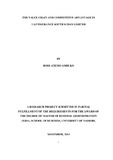| dc.description.abstract | Competition is at the core of the success or failure of a firm. This realisation underpins the importance of crafting and executing a competitive strategy in search of a favourable competitive position in an industry, the arena where competition occurs. An appropriate competitive strategy enables a firm to remain competitive and achieve above average returns. Various theories assert that a formidable competitive strategy and advantage can be achieved by disaggregating the firm into its strategically relevant activities and understanding how each of these activities is performed. According to these theories, a firm gains competitive advantage by performing these activities at a lower cost than its competitors or by performing the activities more uniquely, relative to competition. This is because each activity can contribute to a firm’s relative cost position or create a basis of differentiation. This study sort to test whether these theories and models actually work in the real world. The study focused on a service firm in an insurance industry, UAP Insurance South Sudan. The study had two distinct objectives: To establish the activities that constitute the value chain of UAP South Sudan (UAP SS) and to establish the value chain activities that are associated with the firm’s competitive advantage. The research methodology used was case study. Data was collected from both primary and secondary sources. Primary data was collected through an interview guide with open ended questions, administered to managers in the study unit. Secondary data was sourced from both external and internal sources. Data collected was qualitative in nature and therefore analysed through content analysis. The findings of this study reinforce the fact that sources of competitive advantage are inherent in a firm’s value chain. For a typical insurance firm, the choice to be a differentiator or cost leader is predominantly determined by policy choices on product profile; distribution channels; investments in human capital development, marketing communication and brand building; and levels of integration. Whichever competitive strategy a firm is pursuing, it must seek to effectively communicate the same to all immediate stakeholders for unity of purpose in execution. Largely, the study revealed that the generic value chain as postulated by Porter (1998) applies in service firms. It’s recommended that a study on the entire industry to determine the typical industry value chain or similar researches in other insurance firms are replicated to establish whether there is consistency on value activities. | en |

